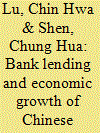| Srl | Item |
| 1 |
ID:
113009


|
|
|
|
|
| Publication |
2012.
|
| Summary/Abstract |
Using a city-level dataset over the period 2004-2006, the present study investigates the relationship between bank lending and the economic growth of Chinese cities. Unlike past studies, we divide bank lending into loans from three types of banks: foreign banks, city banks and other banks. Our findings are threefold. First, the lending of foreign banks exhibits a strong and positive association with the economic growth of Chinese cities. Second, foreign direct investment in the sampled cities enhances the lending effects of foreign banks, but reduces the lending effects of other banks on the economy of Chinese cities. Third, the effects of city competitiveness are similar to those of foreign direct investment; that is, city competitiveness augments the lending effects of foreign banks but reduces the lending effects of other banks.
|
|
|
|
|
|
|
|
|
|
|
|
|
|
|
|
| 2 |
ID:
160031


|
|
|
|
|
| Summary/Abstract |
We estimate the determinants of credit and of non-performing assets (NPAs) using a firm and a bank panel with data up to 2015 in order to test bank lending against the aggregate demand channel as an explanation for slow Indian credit growth. The results support demand as the key constraint. Only demand variables affect corporate credit for a broad set of firms. Balance sheet weakness reduced credit only for a narrow subset of indebted firms in a difference-in-difference type analysis. Even so, sales remained the dominant variable. From the bank panel, the asset quality review (AQR) did have a strong negative effect on advances but gross NPAs did not. While high interest rates and low growth raised NPAs, so did past credit. Low demand not only reduced credit, it also increased NPAs. That the capital adequacy ratio (CAR) significantly reduces NPAs points to the productivity of fund infusion. When other determinants are controlled, bank ownership does not affect NPA ratios, again supporting external shocks as causal. The results suggest that apart from structural reform to clean balance sheets, recovery of demand is necessary for revival of credit growth.
|
|
|
|
|
|
|
|
|
|
|
|
|
|
|
|